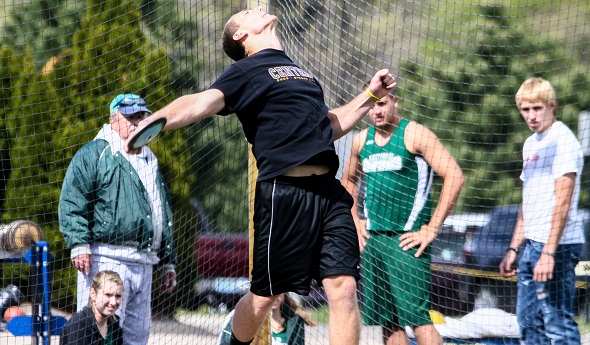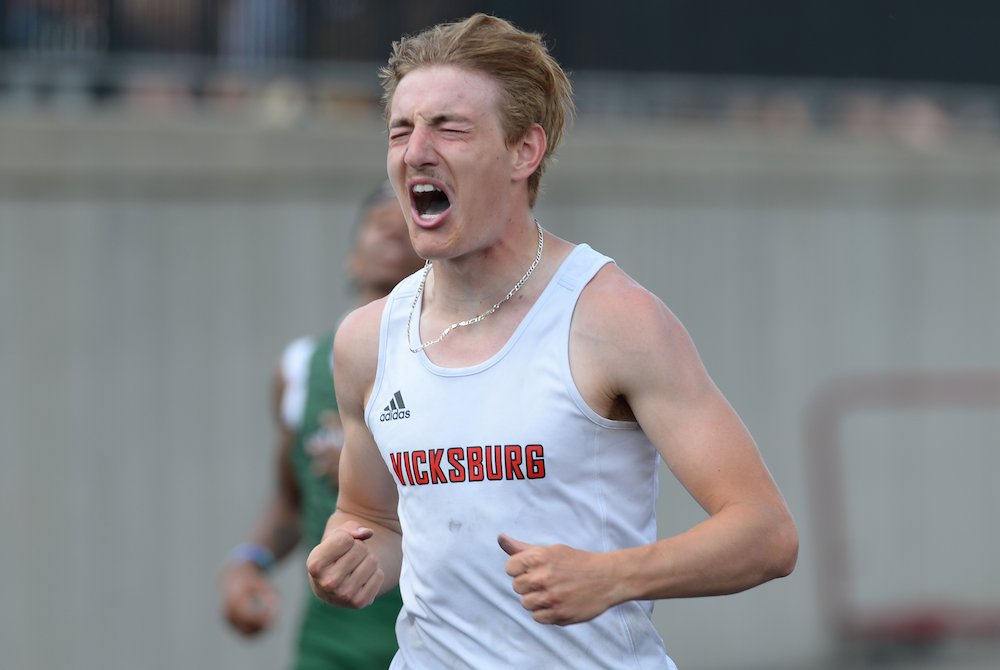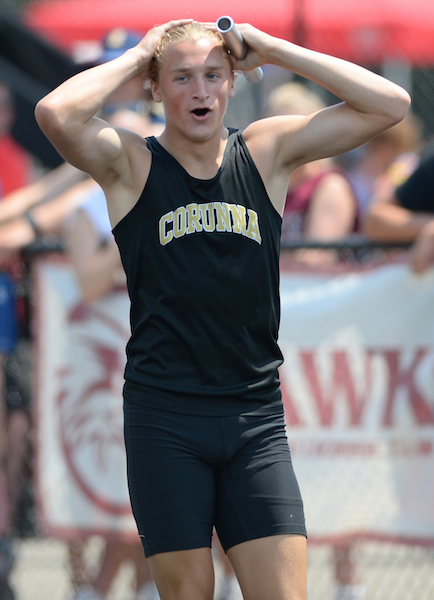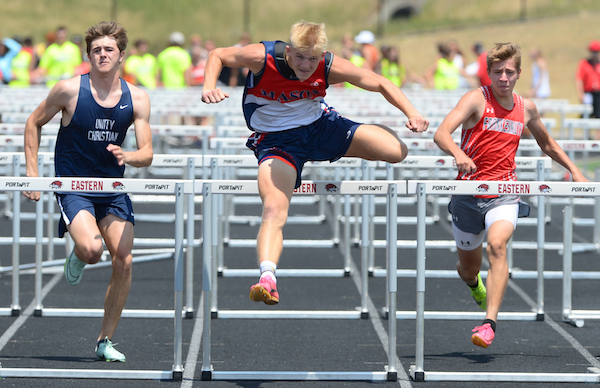
The Throws of a Record-Setting Season
May 3, 2012
By Geoff Kimmerly
Second Half editor
While other kids have basketball hoops in their driveways, Cullen Prena and his sisters have a discus ring.
“I wish,” Cullen said Wednesday when asked if it was so.
You won’t find shot put craters in the family's lawn either.
But drive past the Prenas’ home when his sisters are home from college, and there’s a chance you’ll catch the Walled Lake Central junior and his Big Ten thrower siblings, Kari (University of Michigan) and Kelsey (Michigan State), talking over their craft.
“My sisters got me into it,” Cullen said. “It was a random summer day, and they were going to Central to throw. They asked me if I wanted to go with, and I said ‘Sure.’
“Ever since then I’ve been all into it. It’s basically taken over my life.”
 Those first tosses came in the summer before Prena entered seventh grade. Five years later, he’s making a bid to go down as Michigan’s top high school thrower of all-time.
Those first tosses came in the summer before Prena entered seventh grade. Five years later, he’s making a bid to go down as Michigan’s top high school thrower of all-time.
The fifth-place finisher in discus at last season’s MHSAA Division 1 Final Meet, Prena quickly has established himself as a heavy favorite this spring. He receives a Second Half High 5 this week after throwing an incredible 187 feet, 7 inches to win discus at Saturday’s Oxford Invitational, on top of also winning the shot put with a toss of 52-1.
Earlier in April, Prena topped 180 feet in discus two more times, in the process breaking both his school and then the Oakland County records that had both stood for at least 29 years according to a report by the Oakland Press.
And here’s the kicker: Prena’s top discus throw last season was a solid – but compared to now, mere – 159-9.
“His increase over the course of time, the average spectator can’t see it. But from sixth grade, he’s been training,” said Walled Lake Central boys track coach Nebojsa Stojkovic, who also works with the team’s throwers.
“You know how to gauge kids based on worth ethic and what their bodies are able to do. When freshman year he threw 144 feet, I knew the talent that was coming up.He’s got God-given ability that’s different from everyone else.”
That combination has made Prena something to behold this season.
His work ethic has benefited him with an increase in strength, evidenced by 30-40 percent improvements in all of his weight room lifts over the last year. Prena formerly played football, basketball and baseball, but decided to focus solely on weight training for track this school year in part after tearing a meniscus during his sophomore football season.
And then there’s two natural gifts for a thrower – Prena is double-jointed, allowing him increased flexibility for a stronger whip motion on his discus tosses. He also gets additional power from a wingspan that measures longer than his 6-foot-2 height.
He threw well at indoor competitions during the winter, and was tossing the discus consistently in the 170s when outdoor practice began this spring. In his team’s first meet, against White Lake Lakeland, he threw the discus 177 and then a best of 184-7, and also tossed the shot put 52-10 – more than three feet better than his previous outdoor personal-best in the latter event.
“It was hard to sleep (at night) after a meet when you throw a great throw like that,” Prena said.
Aside from some tires during workouts, Prena hasn’t tried tossing other heavy objects. “Other than my parents and my sisters; that’s about it,” he said, joking, of course.
But he's in serious pursuit of the MHSAA Finals record for discus. Prena’s best toss this season would’ve won every MHSAA Final dating back to 2003 and all seven of last season’s Finals (four Lower Peninsula, three Upper) by at least a foot.
That Finals record of 197-11 belongs to former Portage Northern standout Joey Sarantos, who set it in 2001. Prena must improve another 11 feet – which seems like a logical next step after this spring's gigantic 28-foot jump.
“Last year’s state meet ... didn’t quite go the way I wanted it to, and it’s been in the back of my mind since then,” Prena said. “Coming off of weight training, I kinda expected (the improvement). But you don’t know until you see the stuff. And then I started realizing it, and it was setting in that this is real. This is ridiculous."
PHOTOS: (Top) Walled Lake Central's Cullen Prena warms up before the discus throw that would break the Oakland County record. (Middle) Prena surveys the scene before another discus toss. His best this season is 187-7. (Photos courtesy of Walled Lake Central and David Mexicotte.)

Vicksburg's Wright, Corunna Right On in Claiming LPD2 Championships
By
Steve Vedder
Special for MHSAA.com
June 3, 2023
ADA – If Michael Wright was a baseball player, he probably would've been called out on strikes a year ago.
Instead, the Vicksburg senior can celebrate after winning the 200 at Saturday's Lower Peninsula Division 2 Track & Field Finals at Forest Hills Eastern.
The road to the championship in the 200, via a time of 21.72, was anything but a straight line for Wright. An aspiring baseball player, he was cut from the Vicksburg squad as a freshman. His football career, by Wright's own admission, was "on and off." And then a year ago in his first track meet, Wright suffered a leg injury that virtually ended his season. He did return to finish fifth in the 200 at Finals while helping the 400 relay team to a 16th place.
So there is nothing to realistically explain how Wright found himself in the position Saturday at sweltering Forest Hills Eastern to win a championship. Except for returning this season to break the school record in the 200 four times in two months. Well, that and willpower and simple desire.
 "I knew I could finish high, maybe in the top five. But this is better," said Wright, who credits drinking large quantities of milk for his resurgence. "I looked to football because I didn't think I could bounce back for track. But I overcame the bumps, the obstacles."
"I knew I could finish high, maybe in the top five. But this is better," said Wright, who credits drinking large quantities of milk for his resurgence. "I looked to football because I didn't think I could bounce back for track. But I overcame the bumps, the obstacles."
While Wright was jump-starting his track career, Corunna won the team title with 41 points. Mason and Forest Hills Eastern tied for second with 35. Whitehall was fourth with 33 points, and Frankenmuth fifth with 29 points.
Corunna coach Jeff Sawyer, who had never won a Finals title in 37 years coaching at Owosso and three more at Corunna, said the championship came after little fanfare during the season. Virtually right up until the time Corunna hauled off its first-place trophy, Sawyer said it was never really on his team's mind. The title came after the team managed only a runner-up finish at the Regional.
"We kind of low-keyed it," he said. "We knew scoring 40 points was possible. We lost to Frankenmuth by one point at the Regional. … We were a little disappointed we didn't win, but we had some good times today. We knew it was possible.
"Every day we just come and do what we do. We talk about getting better every day with PRs (personal records). And we're still getting better because we have some tough guys. Just competitive, tough kids. But we were the underdogs."
Corunna had only two firsts on Saturday, in the 400 relay (42.63) and Wyatt Bower in the long jump (22-8½).
Among the individual highlights was Frankenmuth senior Dalton DeBeau, who successfully defended his Finals title in the discus (171-6). He was fifth in that event as a sophomore and after winning a year ago, was considered a good bet to repeat.
"I kind of expected it," said DeBeau, who will compete at Michigan State next spring. "There wasn't a lot of pressure. I knew what had to be done. I threw 160 feet on my first throw to get in the finals, and that helped right away. I knew I could go all out."
 Berrien Springs' Jake Machiniak won the 100 (10.54) while the team also captured the 800 relay (1:28.18). Machiniak said his season hasn't been without its share of difficulties. There was a time when he couldn't seem to come out of the starting blocks smoothly. But beginning with the conference meet where he ran school record 10:73, Machiniak felt himself back on course.
Berrien Springs' Jake Machiniak won the 100 (10.54) while the team also captured the 800 relay (1:28.18). Machiniak said his season hasn't been without its share of difficulties. There was a time when he couldn't seem to come out of the starting blocks smoothly. But beginning with the conference meet where he ran school record 10:73, Machiniak felt himself back on course.
"There were ups and downs. I struggled in the middle of the season," he said. "But my teammates helped me through some difficulties. I came here to finish the job; I knew I could do something here."
Mason's Tyler Baker won the 100 hurdles (14.63) to complete a long journey that included finishing just ninth in last year's prelims. The success was as simple as putting in loads of offseason work.
"I practiced and did stuff about every day," he said. "I might not be the fastest, but I make up for that in form. It's a fine-tuning thing. Everyone wants to be faster."
Mason also got a championship from A.J. Mantel, who captured the 300 hurdles (38.90).
Among other highlights was Forest Hills Eastern senior Aiden Sullivan successfully defending a 2022 title on his own home turf. He won Saturday's 800 (1:53.92).
Adrian won the 3,200 relay (7:39.77), while Grand Rapids Christian took the 1,600 (3:24.49).
Alma had two individual winners in Michael Howey in the shot (55-08) and Jacob Dunlap in the high jump (6-7).
The other champs were Kyle Eberhard of Linden in the 1,600 (4:14.79), Whitehall's Trannon Ayler in the 400 (48.83), Freeland's T.J. Hansen in the 3,200 (9:11.56) and Sam Vesperman of Grosse Ile in the pole vault (15.01). Chelsea senior Jacob Nelson competed in the adaptive 100 (27.28), 200 (57.71) and shot put (6-6).
PHOTOS (Top) Vicksburg's Michael Wright celebrates after winning the 200 on Saturday. (Middle) Corunna's Tarick Bower enjoys a moment after anchoring the winning 400 relay. (Below) Mason's Tyler Baker, center, works to stay ahead in the 110 hurdles. (Photos by Dave McCauley/RunMichigan.com.)

